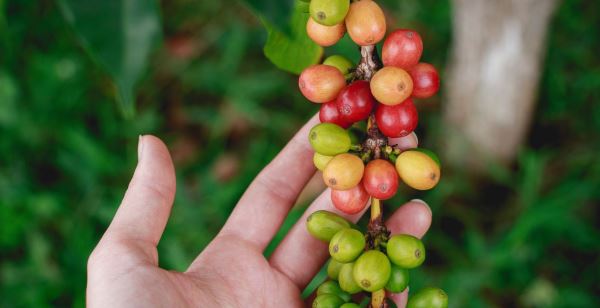So, you want to know where coffee beans come from? Then now's your chance to find out a bit more about it.
This is the first part of a series of posts on the journey of the coffee bean from the farmer all the way through to the point where it ends up in your cup as a lovely, tasty cup of coffee.
Let's start with a simple fact that you may or may not know. The bean we refer to is not a bean at all. In fact it's the seed of a cherry. To be more specific, the cherry of the coffee tree (coffea arabica to be precise).

Growing & Harvesting the Coffee Bean
Coffee cherries are ripe when they turn red and can then be harvested. The problem with harvesting the fruit is that they don't all ripen at the same time, even on the same branch of a tree.
This means that, unfortunately for the farmer, all cherries have to be picked carefully by hand. It's a time-consuming, laborious and therefore expensive process. The cost of harvesting represents about half the overall annual costs of a farm.
Coffee requires a specific set of conditions in order for it to grow. These conditions are generally found only in the Tropics where there is plenty of rainfall and sunshine. Although the plants need a lot of rain, they don't like it too hot. In fact, the coffee tree likes the temperature to be fairly constant throughout the year. They actually also like a bit of shade.
You therefore find most coffee plantations at a reasonably high altitude, where the conditions are cooler. However, it must not be too cool - the trees die if the temperature drops below freezing point.
New coffee trees are grown from seed in nurseries and are ready to harvest their first fruit after 3 to 4 years. They then continue to bear fruit for between 20 and 30 years. The coffee cherry takes about 6 to 8 months to ripen so there can only really be one harvest per year.
Depending on their location in the world, of course, harvesting occurs at different times of the year. North of the Equator - in Ethiopia and Central America, for instance - the harvest takes place between September and December. South of the Equator the main harvest is in April or May. Equatorial countries, such as Colombia, can harvest fruit all year round.
The Coffee Bean Processing Steps
To prepare coffee beans for export, several meticulous process steps are undertaken to ensure the quality and consistency of the beans.
Hulling
The first step is hulling, where machinery is used to remove the outer layers of the coffee beans. For wet processed coffee, this involves stripping away the parchment layer known as the endocarp. In the case of dry processed coffee, the entire husk – consisting of the exocarp, mesocarp, and endocarp – is removed.
Polishing
Following hulling, there is an optional polishing step. During polishing, machines buff the beans to eliminate any remaining silver skin, a thin layer covering the bean. Though polished beans are often perceived as being of higher quality, the effect on the coffee's final taste is generally minimal.
Grading and Sorting
The next phase is grading and sorting, crucial for standardizing bean quality. This process involves categorizing the beans by size and weight. Mechanical screens are used for sizing, with beans passing through holes of varying diameters—measured in 1/64’s of an inch—to determine their size category.
Additionally, pneumatic sorting employs air jets to separate beans by density, effectively distinguishing between heavier, quality beans and lighter, potentially lesser-quality ones.
Colour sorting is also performed to identify and remove beans with visual imperfections or colour inconsistencies. This can be done manually or with the help of specially designed machines.
Finally, any defective or substandard beans are discarded. This includes beans that do not meet size specifications, show signs of over-fermentation, are damaged by insects, or remain un-hulled. The removal of these beans is critical in some countries and is typically executed using both manual and automated methods to maintain a high standard of the final product.
These processes collectively ensure that only the best coffee beans are packaged and exported, maintaining the integrity and reputation of the coffee-producing region.

This is the cherry split in two so you can see the size of the coffee bean inside. The outer part (red) is the pulp, which is removed whilst processing the bean. The inner part (grey) is what makes our lovely cup of coffee.
Coffee Bean Processing Methods
There are generally two methods to process the coffee bean. The dry, or natural, method and the wet (washed) method. The whole aim of both methods is to remove the cherry pulp and get the overall moisture content of the bean down to about 12%.
The Natural Processing Method
This was the original way of processing the coffee bean and is still carried out in parts of the coffee growing world today, particularly where there may be a shortage of the copious amounts of water required for the wet method.
The natural method involves spreading the coffee cherries out in a thin layer to dry in the sun. To prevent the cherries from rotting or getting mouldy, they are frequently turned. It is therefore a very labour intensive process but doesn't require as much machinery or any water.
Once dry, the outer husk of skin and fruit is removed mechanically in a mill before being stored ready for export.
The Washed Processing Method
This is the more mechanical method of processing the coffee bean, and is therefore more expensive. However there is less chance of something going wrong during the process resulting in a coffee bean that is generally worth more, with fewer defects.
After picking, the coffee cherry has its outer skin and most of the flesh removed using a machine called a de-pulper. It is then moved to a water tank where the rest of the flesh is removed by fermentation. The remaining flesh can then be easily washed off.
The coffee bean is then dried out, usually in the sun, by spreading it out on brick patios or raised drying tables.
Alternative Methods
Some producers utilise other methods that are hybrid approaches of the two main methods described above. These methods include:
- Pulped Natural - mainly used in Brazil. Here the final washing is not performed before the beans are dried. Intended to reduce the amount of water utilised.
- Honey - very similar to the pulped natural process and mainly used in Central American countries. Uses even less water than pulped natural through careful controlling of the de-pulping process.
-
Semi-Washed - mainly used in Indonesia where the coffee is de-pulped and then dried to about 30% moisture content. It is then hulled and the naked beans are subsequently dried again.

- Photo credit: Pressicko.sk
Storing and Shipping the Coffee Bean
When they leave the mill, the coffee beans are usually still covered with a layer of parchment. The moisture content is now low enough for the beans to be stored without risk of rotting. At this stage the coffee is stored at rest (in reposo) for up to sixty days to mature.
The coffee is then packaged into either 60kg or 69kg jute bags, a traditional method that has proven effective for preserving the beans during transport. These bags are then loaded into shipping containers, prepared for their journey overseas.
For larger shipments, the green coffee beans are sometimes placed in bulk inside plastic-lined containers, which helps in maintaining the quality during the long sea voyage. Utilizing shipping containers, whether the beans are bagged or in bulk, ensures that the coffee remains secure and protected throughout transit.
Transporting coffee by sea continues to be the cheapest and most environmentally friendly method of shipping, making it the preferred choice for exporters around the globe.
However, it does take time and risks the coffee being exposed to heat and moisture during the journey that may affect its quality. It can be a risky, and somewhat frustrating, business!
Roasting the Coffee Beans
During the coffee bean roasting process, the beans are subjected to high temperatures to develop their flavour and aroma profiles.
Initially, the roasting machinery heats to approximately 230 degrees Celsius, providing a uniform heat that prompts a transformation within the beans. The beans, which are continuously agitated to prevent charring, gradually heat up to about 200 to 210 degrees internally.
At this stage, they begin to brown and release caffeol, a fragrant oil essential for the characteristic coffee taste and scent. This phase, known as pyrolysis, is critical for flavour development.
Once the desired roast level is achieved, the beans are quickly cooled using air or water cooling methods to halt the roasting process and maintain the beans' aromatic freshness.
Typically, the roasting occurs close to where the beans are sold, ensuring consumers enjoy the benefits of freshly roasted coffee.
Tasting and Evaluating the Coffee Beans
Coffee quality assessment, commonly known as cupping, is a systematic process performed in specialized rooms to ensure optimal conditions.
The evaluation begins with a visual inspection of the coffee beans to assess their condition and quality.
After this, the beans are roasted in a small, controlled laboratory roaster. Once roasted, they are immediately ground and steeped in boiling water with precision in temperature control to maintain consistency.
The critical evaluation starts with the cupper, the professional responsible for tasting the coffee, smelling the brew to appreciate its aromatic qualities, which are crucial indicators of its overall quality.
After the initial aroma check, the coffee is allowed to sit undisturbed for a few minutes, during which a crust of grounds forms on the surface. The cupper then gently breaks this crust to stir the coffee, releasing a new burst of aromas, and smells it once more before proceeding to taste.
Tasting involves a unique technique where the cupper slurps a spoonful of the coffee briskly, allowing the coffee to spread across the taste buds. This action helps to capture the full spectrum of flavours and mouthfeel, enhancing the ability to detect nuances. The coffee is then spat out after tasting to avoid over-caffeination and to maintain the cupper’s palate sensitivity.
The cupping process includes sampling various batches and types of beans daily, assessing each for its distinctive attributes and potential defects. This evaluation helps in making decisions about bean selection, blending, and roasting levels.
A seasoned cupper can differentiate among hundreds of samples in a day, noting even the most subtle distinctions. This meticulous testing process ensures that only the highest quality coffee reaches consumers.
Grinding the Coffee Beans
To maximize flavour extraction, the size of the coffee grounds should correspond to the duration of water exposure.
For instance, a shorter brewing time, such as in an espresso machine, requires a finer grind to fully extract the flavour quickly. On the other hand, brewing methods that allow the water to be in contact with the grounds longer, like a drip coffee system, are best suited to coarser grounds.
This tailored grinding ensures the best flavour and efficiency in coffee brewing.


